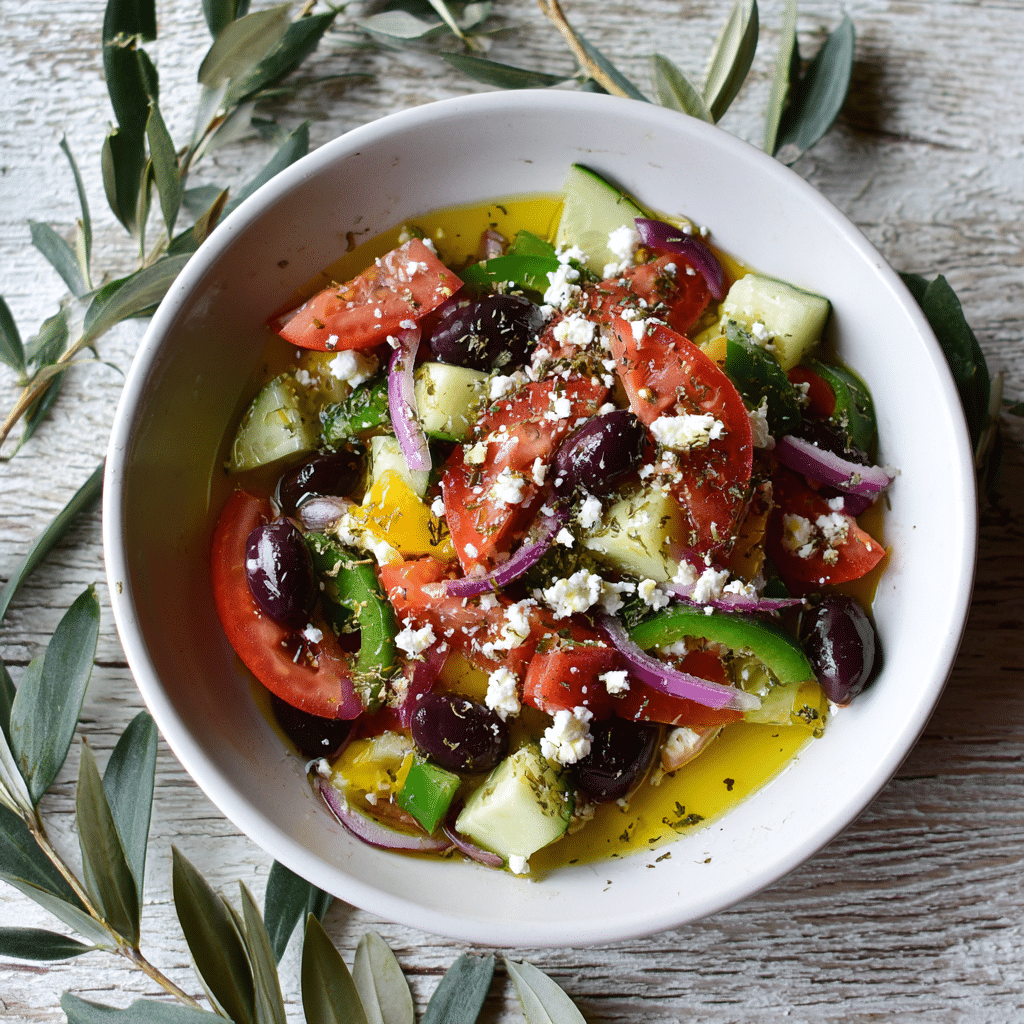Greek Salad
A Greek salad is a vibrant, refreshing combination of crisp vegetables, briny olives, and creamy feta cheese, all dressed in a simple olive oil and vinegar vinaigrette. It celebrates the colors and flavors of the Mediterranean, offering a light yet satisfying dish that works perfectly as a side or a light main course.
Why You’ll Love This Recipe
-
Fresh, vibrant flavors: Ripe tomatoes, crisp cucumbers, and fragrant oregano come together for an irresistible taste.
-
Quick and easy: Ready in just 15 minutes, with minimal chopping and no cooking required.
-
Healthy and nutritious: Packed with vegetables, healthy fats from olive oil, and protein from feta cheese.
-
Customizable: Easily adapt with additional vegetables, herbs, or proteins to suit your preferences.
ingredients
(Tip: You can find the complete list of ingredients and their measurements in the recipe card below.)
-
Ripe tomatoes, cut into wedges
-
English cucumber, sliced into half-moons
-
Red bell pepper, thinly sliced
-
Red onion, thinly sliced
-
Kalamata olives, pitted
-
Feta cheese, crumbled
-
Extra-virgin olive oil
-
Red wine vinegar
-
Dried oregano
-
Sea salt
-
Freshly ground black pepper
directions
-
Prepare the vegetables. Rinse and dry all produce. Slice the tomatoes into wedges, cut the cucumber into half-moons, thinly slice the bell pepper and onion, and pit the olives if necessary.
-
Make the dressing. In a small bowl, whisk together olive oil, red wine vinegar, dried oregano, a pinch of salt, and a generous grind of black pepper.
-
Assemble the salad. In a large bowl, combine the tomatoes, cucumber, bell pepper, red onion, and olives. Pour the dressing over the top.
-
Add the cheese. Gently sprinkle the crumbled feta cheese over the salad.
-
Toss and serve. Toss lightly to distribute the dressing and cheese evenly. Serve immediately for the best texture and flavor.
Servings and timing
-
Servings: 4
-
Preparation time: 15 minutes
-
Total time: 15 minutes
Variations
-
Add lettuce: Incorporate crisp romaine or butter lettuce for extra volume.
-
Include protein: Add grilled chicken, shrimp, or chickpeas to transform this into a heartier main course.
-
Herb twist: Stir in fresh herbs such as parsley, mint, or dill for additional brightness.
-
Different cheese: Substitute feta with fresh mozzarella or burrata for a creamier texture.
-
Spice it up: Add a pinch of red pepper flakes or a dash of chili oil to the dressing for a little heat.
storage/reheating
-
Storage: Transfer any leftovers to an airtight container and refrigerate for up to 2 days. Keep dressing separate if possible to maintain vegetable crispness.
-
Reheating: Greek salad is best enjoyed cold; do not reheat, as the vegetables will become limp and the cheese will lose its texture. Simply give any stored salad a gentle toss before serving.
FAQs
What type of tomatoes are best for Greek salad?
Ripe, firm tomatoes such as vine-ripened or Roma tomatoes work well, offering sweetness without excess juice.
Can I make Greek salad ahead of time?
You may prepare the vegetables and dressing separately up to a day in advance; combine them just before serving to avoid sogginess.
What kind of feta cheese should I use?
Authentic Greek feta is traditionally made from sheep’s milk or a blend of sheep and goat’s milk. Choose a block of feta rather than crumbled for better texture.
Can I substitute another vinegar?
Yes, white wine vinegar or lemon juice can replace red wine vinegar, though the flavor profile will vary slightly.
Is Greek salad gluten-free?
Yes, this recipe is naturally gluten-free, provided all ingredients (especially the olives and vinegar) are labeled gluten-free.
How do I keep the vegetables crisp?
Pat vegetables completely dry after washing, and dress the salad just before serving to maintain crunch.
Can I add lettuce to this salad?
Absolutely; romaine or butter lettuce adds a pleasing crunch and makes the salad more substantial.
What other olives can I use?
While Kalamata olives are traditional, you can substitute Niçoise or Castelvetrano olives for different flavor nuances.
How long does Greek salad last in the fridge?
Up to 2 days, though it is at its best on the day it is made.
Can I freeze Greek salad?
Freezing is not recommended, as the high water content in the vegetables will lead to a mushy texture upon thawing.
Conclusion
This Greek salad is a hallmark of Mediterranean cuisine—simple, fresh, and bursting with flavor. Whether you serve it alongside grilled meats, enjoy it as a light lunch, or bring it to a summer gathering, it is sure to be a crowd-pleaser. Delight in its crisp textures and bright, balanced dressing any time you crave a taste of the Mediterranean
PrintGreek Salad
My Greek salad recipe made with cucumbers, tomatoes, red onion, olives, and feta is so refreshing and perfect for summer.
- Prep Time: 20 mins
- Cook Time: 0 mins
- Total Time: 1 hr 10 mins
- Yield: 4 servings 1x
- Category: Salad
- Method: No-cook
- Cuisine: Greek
- Diet: Vegetarian
Ingredients
- 2 large English cucumbers
- 1 pinch kosher salt
- 2 cups cherry tomatoes
- ¼ red onion
- ½ red bell pepper
- ½ cup pitted Kalamata olives
- ½ cup pitted green olives
- 2 tablespoons minced fresh oregano
- salt and freshly ground black pepper to taste
- 1 pinch cayenne pepper, or to taste
- ¼ cup red wine vinegar, or to taste
- ⅓ cup olive oil, or to taste
- 1 (4 ounce) package feta cheese, diced, divided
- 1 teaspoon minced fresh oregano, or to taste
Instructions
- Peel off a few strips of cucumber skin using a channel knife, creating a striped pattern. Cut cucumbers in half crosswise. Cut each half into quarters before cutting into 1/4- to 1/2-inch slices. Place into a colander; toss with some kosher salt and let sit for 10 to 15 minutes.
- Meanwhile, cut cherry tomatoes in half. Rinse cucumbers; drain thoroughly for 10 to 15 minutes more.
- While cucumbers are draining, slice onion thinly. Cut bell pepper into strips. Turn knife diagonally and cut strips into diamond-shaped pieces. Slice Kalamata and green olives.
- Combine cucumbers, tomatoes, onion, bell pepper, olives, and 2 tablespoons oregano in a bowl. Season with salt, black pepper, and cayenne. Sprinkle in vinegar and toss thoroughly. Drizzle in olive oil. Add about 2/3 of the feta cheese and toss again. Cover with plastic wrap and refrigerate for 30 to 60 minutes.
- Give the salad another mix. Taste and season as desired. Scatter remaining feta cheese on top and garnish with remaining oregano.
Notes
- Giving exact amounts is difficult, since this really should be made to your taste, so please use the ingredient list as a very rough outline.
- If you need to make this the day before, make the dressing separately, and then mix everything 30 to 60 minutes before serving.
- Use 1/2 teaspoon dried oregano if you don’t have fresh oregano.
Nutrition
- Serving Size: 1 serving
- Calories: 352
- Sugar: 2g
- Sodium: 1250mg
- Fat: 32g
- Saturated Fat: 8g
- Unsaturated Fat: 24g
- Trans Fat: 0g
- Carbohydrates: 13g
- Fiber: 3g
- Protein: 6g
- Cholesterol: 25mg
Keywords: Greek salad, cucumbers, tomatoes, red onion, olives, feta, summer salad, Horiatiki









